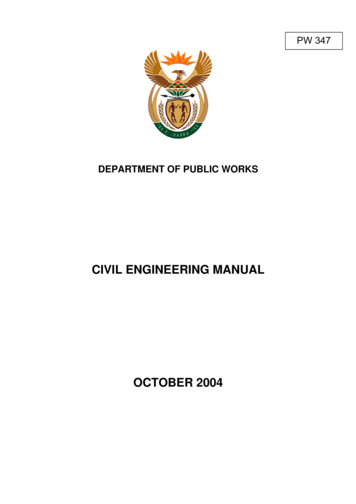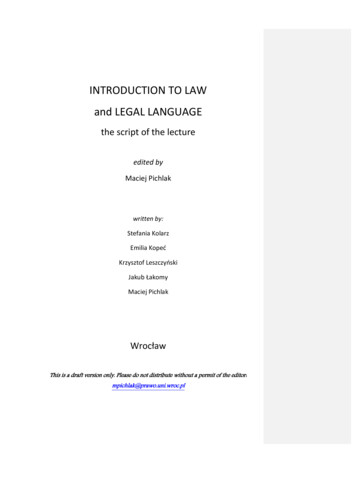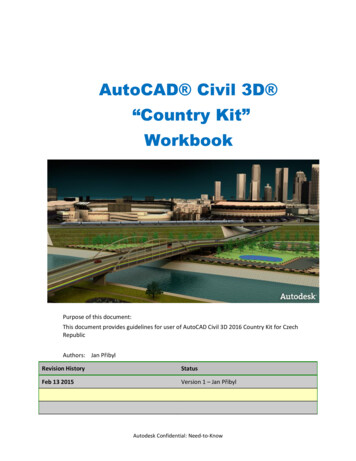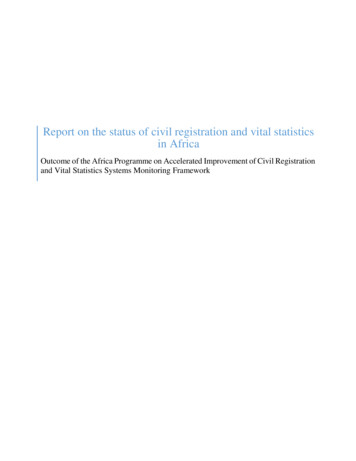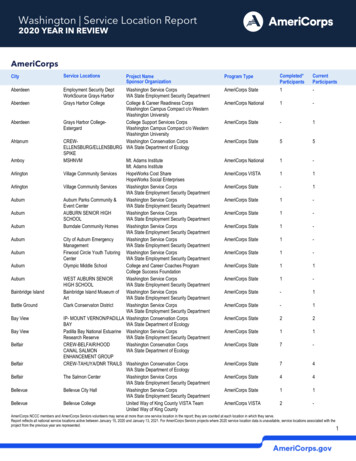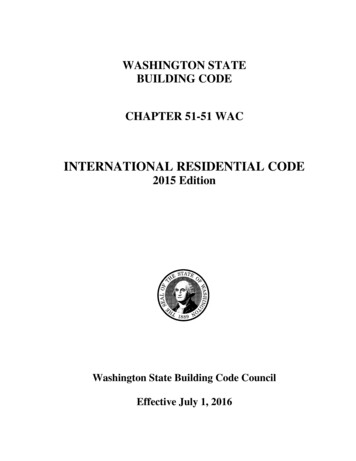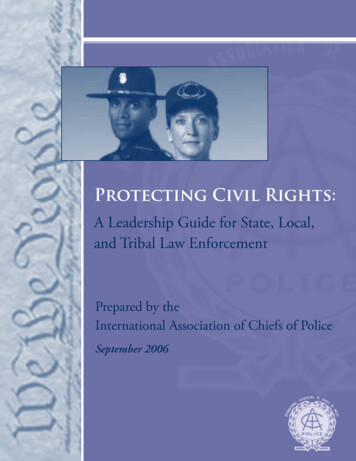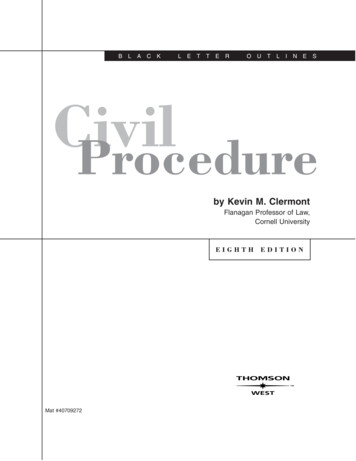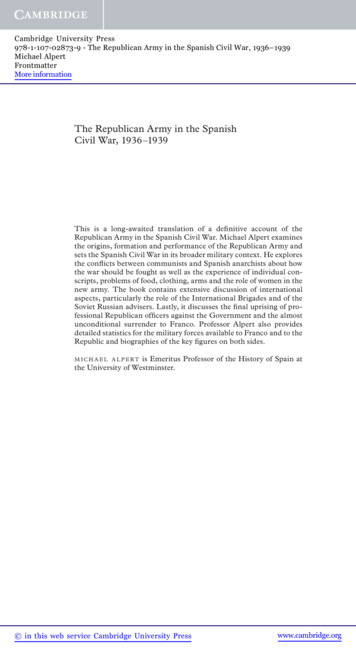
Transcription
2015 WASHINGTON STATECivil Legal Needs Study UpdateCivil Legal Needs Study Update CommitteeWashington State Supreme Court - October 2015
Table of ContentsTABLE OF CONTENTS.1WASHINGTON’S CIVIL JUSTICE SYSTEM MUST SERVE ALL OF US . . .2EXECUTIVE SUMMARY .3INTRODUCTION: FACING COMPLEX PROBLEMS ON THEIR OWN .4SEVEN IN TEN EXPERIENCE SERIOUS CIVIL LEGAL PROBLEMS EACH YEAR. . .5TODAY’S MOST COMMON PROBLEMS.6WHO YOU ARE MATTERS.10DISCRIMINATION AND UNFAIR TREATMENT ARE PREVALENT .12VICTIMS OF DOMESTIC VIOLENCE EXPERIENCE THE MOST PROBLEMS.13MANY ARE ADVERSELY AFFECTED BY DATA TRACKING .14MOST FACE CIVIL LEGAL PROBLEMS ALONE .15A PROFOUND LACK OF CONFIDENCE IN WASHINGTON’S CIVIL JUSTICE SYSTEM.17THE CHALLENGE.18ABOUT THIS UPDATE: WHY, WHO, WHEN, WHERE & HOW .19ECONOMIC SNAPSHOT: MORE WASHINGTONIANS LIVE IN POVERTY.21ACKNOWLEDGMENTS.22COMMITTEE MEMBERS/STAFF.22APPENDICES.2312015 CIVIL LEGAL NEEDS STUDY UPDATE
Washington’s Civil JusticeSystem must serve all of usThis Report summarizes the findings of the 2015 Washington CivilLegal Needs Study Update (CLNSUpdate). Conducted in late 2014, theReport updates a similar study publishedby a task force appointed by the WashingtonState Supreme Court in 2003. Like itspredecessor, this Report was commissionedby a special committee of the WashingtonState Supreme Court.The 2003 Civil Legal Needs Study was thefirst rigorous assessment of the unmetcivil legal needs of low-income families inWashington State. The 2003 study foundthat three of every four households experienced at least one civil legal problem, andthat nearly nine in ten of those who had aproblem did not get the help they needed.The 2003 study galvanized a decade-longeffort to increase capacity to address thecivil legal problems of low-income Washingtonians and secure the resources toachieve this goal.Unfortunately, in the years that followed,the economy fell into recession, throwing greater numbers of Washingtoniansinto poverty, the most since the GreatDepression. The face of poverty changed,as members of racial and ethnic minoritygroups experienced disproportionateconsequences of both this recession and itsaftermath. Changing government policiesand private sector practices also contributed to new and ever more complex legalproblems for those living in poverty.By 2014, the Washington Supreme Courthad become increasingly aware that the2015 CIVIL LEGAL NEEDS STUDY UPDATE2003 Study was outdated and no longer themost relevant or reliable source of information upon which policy makers couldmake investment decisions and legal aidproviders could make strategic decisionsabout where, when and how to target theirlimited services. The Court appointed a12-member Civil Legal Needs Study UpdateCommittee to conduct a fresh assessmentof the prevalence and substance of civillegal problems experienced by low-incomeindividuals and families. The Committeeengaged Washington State University’sSocial and Economic Sciences ResearchCenter (WSU-SESRC) to conduct thestudy. Beginning in June 2015, WSU-SESRCpublished a series of reports outlining indetail the results of the study. These can befound at: http://ocla.wa.gov/reports.This Report synthesizes and presentsthe core highlights of that research.The findings are sobering. Low-incomeWashingtonians routinely face multiplecivil legal problems that significantly affecttheir everyday lives. These problems areexperienced to greater degrees by low-income persons of color, victims of domesticviolence or sexual assault, persons withdisabilities and youth. The compoundeffect of these problems on individuals andfamilies today is even more acute than itwas a decade ago, with the average numberof civil legal problems per low-incomehousehold having nearly tripled since 2003.At the same time, and despite much workover the last decade, our state’s civil justicesystem does not serve Washington’s poorest residents the way that it should. Mostlow-income people do not get the help theyneed to solve their legal problems, andsignificant majorities of low-income peopledo not believe they or others like them willreceive fair treatment by our civil justicesystem.This Report challenges us to do better: It challenges us to ensure that low-incomeresidents understand their legal rights andknow where to look for legal help whenthey need it. It challenges us to squarely address notonly the scope of problems presented,but the systems that result in disparateexperiences depending on one’s race, ethnicity, victim status or other identifyingcharacteristics. It challenges us to be aware of the costsand consequences of administering a system of justice that denies large segmentsof the population the ability to assert andeffectively defend core legal rights.Ultimately, it challenges us to work all theharder to secure the investments neededto deliver on the promise embedded inour constitutional history and our nation’screed – that liberty and justice be madeavailable “to all.”JUSTICE CHARLES K. WIGGINS, ChairCivil Legal Needs Study Update Committee 2
Executive SummaryLow-Income Washingtonians facemultiple civil legal problems but fewget the help they needSome of the key findings: Civil legal issues are common. Seven inten low-income households in WashingtonState face at least one significant civil legalproblem each year. The average number ofproblems per household increased from 3.3in 2003 to 9.3 in the latest, 2014 survey. The most common problems havechanged. Health care, consumer/financeand employment now represent the threeareas with the highest percentage ofproblems.Many Do Not Believe They’llReceive Fair Treatment Fromthe State’s Civil Justice SystemJustice is absent for low-income Washingtonians who frequently experience seriouscivil legal problems.More than 70% of the state’s low-incomehouseholds experience at least one civillegal problem each year on matters affectingthe most fundamental aspects of their dailylives, including accessible and affordablehealth care; the ability to get and keep a job;the right to financial services and protection from consumer exploitation; and thesecurity of safe and stable housing.Those who face one such problem, oftenhave other serious and related problems atthe same time. One struggling mom says shefeels as though one problem simply leads toanother:“The day I got custody of my son, I was laidoff. Three years later, I’m still having troublemaking a living. My son is ADHD and autistic. I can’t keep minutes on my phone andkeep food in my house. Police have beenracial profiling. It’s just been hard.”Many see their problems compounded byrace, ethnicity, age, disability, immigrationstatus or status as a victim of domesticviolence or sexual assault.While the U.S. Constitution guarantees allpeople, regardless of their ability to pay, theright to legal representation in a criminaltrial, it does not extend that right to peoplewho have civil legal problems. That leavesa majority of low-income individuals andfamilies in Washington to face and resolvetheir problems alone – without the helpof a lawyer, no matter how complex orlife-changing a problem may be. And itleads many to feel a high level of distrust inthe civil justice system and its ability to helppeople like them.Indeed, the Justice Gap1 in Washingtonis real and it is growing. This calls out fora thoughtful, significant and coordinatedresponse.This Report spotlights the key findings ofthe 2015 Civil Legal Needs Study Update– a rigorous and methodologically soundinquiry into the type and prevalence of civillegal problems low-income families andindividuals face today. Race, ethnicity and other personalcharacteristics affect the number andtype of problems people have. Thesepersonal characteristics also affect thedegree to which people experience discrimination or unfair treatment and the degreeto which legal help is secured. Victims of domestic violence and/orsexual assault experience the highestnumber of problems per capita of anygroup. Many are adversely affected by datatracking. In addition to discriminationand unfair treatment of legally protectedclasses of people (for example, race),significant percentages of low-incomehouseholds experience unfair treatmenton the basis of their credit histories, priorinvolvement with the juvenile or adultcriminal justice system and/or their statusas a victim of domestic violence or sexualassault. There is a significant legal literacyproblem. A majority of low-income peopledo not understand that the problems theyexperience have a legal dimension and thatthey would benefit from getting legal help. The vast majority of people face theirproblems alone. More than three-quarters (76%) of those who have a legalproblem do not get the help they need. Most low-income people have limitedconfidence in the state’s civil justicesystem. Also perceptions about the fairness and effectiveness of the system to helpsolve problems experienced by “people likeme” differ significantly on the basis of race,ethnicity and other characteristics.1 The “Justice Gap” refers to the difference between the number of problems experienced by low-income Washingtonians for which they need legal help and the actual level of legal help that they receive to address such problems.32015 CIVIL LEGAL NEEDS STUDY UPDATE
INTRODUCTION:Facing complex problemson their own“I had no idea what I was doing,”ANNA CONFESSEDDesperate to stop her abusive ex-spouse fromgaining custody of their daughter but unableto afford a lawyer, Anna spent hours in thelocal library with court documents spread onthe counter and plugging quarters into thecopy machine.She didn’t understand how the judicialsystem worked and admitted to making “alot of mistakes.” She missed so many days ofwork to be in court that she lost her job at aSkookum shipyard.Every year Washington’s lowest incomeresidents experience an onslaught of civillegal problems. A mother and her kidsare evicted from their apartment following a domestic violence dispute. A familydrowning in medical bills sees no otherchoice but bankruptcy. Low-wage workersdo not get paid or they have wages improperly withheld. Families are harassed by debtcollection companies, often for non-existent debts. Children do not get the specialeducational services that they need and fall2015 CIVIL LEGAL NEEDS STUDY UPDATEbehind in school. Couples divorce and fightover child custody and family matters.Low-income individuals and families facethese and other significant life-changingissues without legal help and with littleunderstanding of how to navigate the justicesystem on their own.The Washington Civil Legal Needs StudyUpdate assesses the type and complexity ofcivil legal problems low-income individualsand families face. The quotes and personalstories contained within this Report portraythe real-life experiences of many whosevoices are not often heard.The updated data is drawn from a statewidesurvey of more than 1,600 low-incomeWashingtonians conducted by WSU-SESRCin late 2014. (See Appendix A for detailedsurvey methodology). It reveals substantivechanges both in the number and nature ofproblems confronting those living in poverty since the 2003 Washington Civil LegalNeeds Study was published.This Report outlines the nature of the civillegal problems low-income Washingtonians are grappling with today. The intentis to inform discussions about how theseissues are addressed by the public, stateleaders, legal aid providers and the civiljustice system.More than 400 people who participated inthe survey offered additional, largely anonymous comments when asked at the endof the questionnaire if they had anythingmore to add. Some of those comments arereflected within without their names orother identifying information.This Report also contains stories of peoplewho did not participate in the survey butagreed to share their stories so that justicesystem leaders, policy makers and the publicwould understand the very real humanexperience behind the numbers. Theirnames have been changed and their storiesare italicized.4
Seven in ten low-income households faceat least one civil legal problem each year and they likely have more than one“My homelessness was the result of job loss, dueto an extended illness and hospitalization.”2014 SURVEY RESPONDENTThe Civil Legal Needs Study Update underscores what many people know all too well:One problem often leads to another, andthen another. Some people find themselvescaught in a spiral of legal problems thatcauses them to lose a job and then, insuccession, their housing and whateverfinancial resources they had.More than 70% of the low-income households in Washington face at least one civillegal problem during a 12-month period.This finding remains relatively unchangedbetween the 2003 Civil Legal Needs Studyand this 2015 Report.However, there is a critical differencebetween 2003 and today: The average number of civil legal problems per householdtripled over the past decade.5The 2003 Civil Legal Needs Study foundlow-income households in the state facedan average of 3.3 legal problems within theprevious 12 months. The 2014 survey revealsthe number of legal problems confrontingWashington low-income residents jumpedto an average of 9.3 problems within ayear’s time.Average number of legalproblems per householdSurvey results comparedHouseholds experienced at least one legal problemAverage number of legal problems per householdHouseholds with four or more legal 54%46.3%2015 CIVIL LEGAL NEEDS STUDY UPDATE
Today’s most common problemsinvolve issues relating to health care,consumer/financial services and employmentDespite expanded access to public andprivate health insurance under the federalAffordable Care Act, health care soaredto the top of the list of the most prevalentproblems facing low-income Washingtonians. More than 43.4% of all 2014 surveyrespondents identified at least one problemrelated to health care, a huge increase from18.8% in the 2003 survey when housingissues were the No. 1 concern.There were other significant changes inthe types of problems experienced bylow-income Washingtonians between2003 and 2014.For example, in 2003 low-income peoplereported the highest prevalence of problems in the areas of housing, family relations and employment. More than 10 yearslater, health care and consumer/financerepresent the most frequent areas wherepeople experience the greatest number ofproblems, with employment closing out thetop three.2015 CIVIL LEGAL NEEDS STUDY UPDATE“I am single and pregnant andhave no idea what my livingsituation will be like in thecoming months. I recentlysustained an injury with nodisability insurance, used all mypaid time off that I was savingfor the birth of my baby and amcurrently worried about how Iam going to pay the bills.”2014 SURVEY RESPONDENT6
CHANGES IN PREVALENCE OF LEGAL PROBLEMS(2003 VS. 2014)43.4%Health Problems18.8%37.6%Consumer, FinancialServices and Credit27.0%33.6%Employment Problems25.3%Municipal services/utilities/law enforcement33.3%29.6%20.4%27.8%Housing Problems41.3%22.8%27.4%Family Related ProblemsEstate PlanningEducation ProblemsProblems involving consumer, debt collection, access to credit and financial servicesrank No. 2 in the list of most common problems reported by Washington’s low-incomehouseholds. Of those who identify at leastone civil legal problem, 37.6% face at leastone problem in the consumer/finance area.25.6%Access to StateGovernment Assistance/Public Benefits2003Reflecting the transition from reliance ongovernmental support to the low-wageeconomy that is prevalent today, nearly half(45%) of all survey respondents reportedthat they were employed at least part-time.Fully one third (33.6%) of all respondents(those actively employed and those notworking) reported at least one problemrelated to employment17.2%11.3%Low-Income WashingtoniansFace Many Other SignificantCivil Legal Issues12.1%8.6%Source: WSU-SESRC2014While access to necessary and appropriatehealth care services is an important problem, issues relating to medical care costrecovery -- medical bills and medical debtand related debt collection -- pose evenmore common problems. And low-incomeWashingtonians do not realize there arelegal remedies to those problems. Forexample, people are not told, nor do theyrealize, they are entitled to charity care at anon-profit hospital. As a result, they do notassert those legal rights or ask a lawyer tohelp them solve such problems.10%20%30%40%The low-income households and individuals who responded to the 2014 surveyreported a total of 7,460 separate civil legalproblems, not including those related todiscrimination and unfair treatment.“I have over 80,000 in medical debtfrom when I didn’t have healthinsurance and am also unable toafford to file for bankruptcy.”2014 SURVEY RESPONDENT72015 CIVIL LEGAL NEEDS STUDY UPDATE
In addition to health care, consumer/finance and employment, other substantiveissues include: Municipal services and utilities.Low-income households experience significant problems with law enforcement, andhave substantial difficulties getting andkeeping essential utility services. Access to government assistance.Individuals and families often have stategovernment-provided benefits denied,terminated or reduced. People experienceproblems related to the Earned IncomeTax Credit or are denied or terminatedfrom federal Supplemental SecurityIncome (SSI) or Social Security DisabilityInsurance (SSDI) benefits. Rental housing. The most commonproblems include landlord disputes, unsafehousing conditions and problems relatedto eviction or termination of a lease. Family-related problems. Principalproblems involve issues arising fromfamily conflict, including child custodyand support and problems associated withbeing a victim of domestic violence orsexual assault. Estate planning and guardianship.Individuals or families need help with awill or estate plan or inheritance problem.Some have difficulty administering anestate, trust or will.HEALTHCAREPercentage of Health-Care Related Problems by Specific IssuesHealth insurance wouldn’t covernecessary items/services22.2%Problems w/debt collection forhealth care bills20.7%Not informed about financialassistance/charity care18.3%Billed incorrectly for services,including co-payments16.8%Denied or dropped fromgovernment health insurance12.8%Denied/restricted necessarypersonal care services11.6%Unable to get insurance throughWA Health Plan Finder11.1%Unable to obtain coverage forneeded medical equipmentDenied health care because ofimmigration statusHad problems associated with along-term care facilityDenied interpreter services by ahealth care provider7.2%3.63.12.5Source: WSU-SESRC10%20%“It would be very helpful if there were moreaccess to low-income legal resources fordisabled people, especially because my roommate and I are in danger of being evicted afterour apartment complex was foreclosed and thenew management does not want low-incomepeople in the complex.”2014 SURVEY RESPONDENT2015 CIVIL LEGAL NEEDS STUDY UPDATE8
Education. The most common problemsinclude issues relating to unsafe schools,school discipline including suspensionand expulsion, and the inability to complete school because of multiple movesand homelessness.CONSUMER, FINANCIAL SERVICES AND CREDITPROBLEMS BY SPECIFIC ISSUEHarassed by creditors21.4%Filed for bankruptcy10.9%Deceptive lending practices9.9%Unable to open a bank account9.5%Denied banking servicesSixteen-year-old Molly finally worked up thecourage to tell her parents she had been sexually assaulted by her brother from the timeshe was 6 until age 12. She also hinted thatshe is a lesbian. Her family not only refusedto believe her, they threatened to pull her outof high school and keep her at home.9.3%Wages were garnished“One day I wasat school andI just didn’t gohome. I didn’thave a job ormoney,”8.9%Credit problems due to identity theft8.7%Problems with payday/other lenders7.1%Problems related to LFO’s/restitution6.7%Problems w/credit repair companies6.7%Deceptive mortgage practices5.4%Req’d to buy financial products w/mortgage3.8%Source: WSU-SESRC5%10%15%20%SAID MOLLY, WHO EVENTUALLYFOUND HOUSING WITH A LEGALASSISTANT’S HELP.EMPLOYMENT PROBLEMS BY SPECIFIC ISSUENot hired or fired unrelated toqualifications or job performance18.6%Unsafe working conditions11.6%Not paid wages due11.5%Suspended driver’s license for non-paymentfines/child support8.9%Denied accommodation for disability8.0%Denied/did not receive allunemployment benefits7.7%Denied compensation/medical/vocationalservices for job injuryProfessional license suspended/revoked6.2%1.62%9Source: WSU-SESRC6%10%14%18%2015 CIVIL LEGAL NEEDS STUDY UPDATE
Who you are mattersThe 2014 survey was designed to measure whether people experience differentproblems or are treated differently becauseof legally protected characteristics such asrace, ethnicity, age, gender, sexual orientation or disability.2The survey also probed whether low-income people are treated differently orunfairly because of their credit historyand a prior juvenile or adult criminalrecord or whether low-income people aretreated differently or experience differentlegal problems because of their status asan immigrant, military service memberor veteran, or because they or someonein their household is involved with thechild welfare system, a victim of domesticviolence or sexual assault, or incarceratedin a juvenile or adult correction facility.The findings show that who you are, indeed,matters.Native Americans, African-Americans,people who identify as Hispanic or Latino,victims of sexual assault, young adults andfamilies that include military members orveterans experience substantially greaternumbers of problems and different types ofproblems than the low-income populationas a whole. Often these problems adverselyaffect their ability to get or keep a job,secure stable housing and access necessaryconsumer credit. They also lead to greaterdifficulties with debt collection and theirability to secure government benefits towhich they are entitled by law.Native Americans andAfrican-Americans ExperienceHigher Rates of Legal Problems Than Other Low-IncomeWashingtonians“The justice system is unfair to black peopleand not willing to help us.” 2014 surveyrespondent2015 CIVIL LEGAL NEEDS STUDY UPDATE“At worksites, because Iam Spanish, I am treatedvery bad.”2014 SURVEY RESPONDENTNative Americans and African-Americansnot only represent a disproportionatelylarger share of Washington’s low-incomepopulation, they also face disproportionately more problems in areas that affect thequality of their daily lives as well as limitfuture opportunities.For example, while one-third (33%) of thegeneral population with at least one civillegal problem has an issue related toemployment, well over half (56.7%) oflow-income Native American householdshave an employment problem and close tohalf (44.7%) of low-income African-American households face an employment issue.While fewer than one-third (27.8%) ofall low-income households suffer at leastone problem with rental housing, 42.9%of Native American households, 41.5% ofAfrican-American households, and 37.8%of households that include a person with adisability have rental housing problems.2 The CLNS Update Committee intended to include low-incomepersons who identify as lesbian, gay, bisexual, transgender orwho were questioning their sexual orientation or gender identityor expression as one of the target groups. Questions relating tothis group inadvertently did not get incorporated into the surveyinstrument. The CLNS Update Committee is now updating itssurvey data to ensure fair representation of members of thistarget group.10
PREVALENCE OF LEGAL PROBLEMS BY RACESource: WSU-SESRC70%60%50%40%30%20%WhiteAfrican AmericanGroup members experiencecommon problemsThe Civil Legal Needs Study Update alsosought to determine what problems specificgroups have in common because of theirstatus or history. Below are the top substantive problem areas among the groupsidentified within the survey: Persons with disabilities. Denial ortermination of government disabilityassistance; denial or limited access togovernment services because of failureto make reasonable accommodation fortheir disability; denial or limited access toservices from a private business because oflack of accommodation or other factor. Immigrants. Problems with immigrationstatus, including the inability to securelegal authorization to live or work in theU.S.; denial of housing, employment,health care, etc. because of immigrationstatus; job-related harassment because ofimmigration status. Native Americans. Denial of servicesfrom an Indian tribe or community-basedorganization that serves Native Americans; denial of services from the Bureau ofIndian Affairs or Indian Health Services;11Hispanicproblems with estate planning and protection of inherited trust property; discriminated against or terminated from a job bya tribe or tribally owned business. Military service members and veterans. Denial of veteran’s (VA) disability,educational or other benefits and services;problems related to discharge status;inability to access necessary care forservice-related physical or mental healthconditions. Youth and young adults (Ages 15 to21). Discrimination and unfair treatmentby law enforcement; problems gettinghousing, a job or education due to presentor prior involvement in the juvenile oAs vernsi mst ean ntceentMunicipalS/ U er vtil iceiti sesEmploymernsumCoHealthcare10%AsianNative Americansystem; problems related to involvementin the child welfare or foster care system. Persons involved in the child welfaresystem. Investigated by Child ProtectiveServices (CPS); coerced or attemptedcoercion into giving up custody of child;involuntarily given psychotropic medication to manage behavior. Persons in juvenile and adult correction facilities. Problems with visitationor communication with family membersand friends; lack of access to legal helpor law-related materials; lack of planningor support for re-entry after detention orincarceration. “Discouraged. As a seniorcitizen with disabilities,I feel as though I amoverlooked by the system.”2014 SURVEY RESPONDENT2015 CIVIL LEGAL NEEDS STUDY UPDATE
Many suffer higher degrees of discriminationand unfair treatment because of race, ethnicity andother status-based characteristicsEven though she’d paid both her rent andutility bills, Tiffany’s landlord tried to haveher lights and water shut off and persuadeda police officer to post a three-day evictionnotice on her door.The officer approached Tiffany’s 11-year-oldson while she was away, telling him he didn’twant to “make it harder for folks like you tolive here.” Tiffany, who is African-American,was convinced “folks like you” referred to herrace, especially because the landlord made itclear he wanted to move a white family intothe house.Tiffany found a volunteer lawyer who helpedget the three-day eviction dropped. However,Tiffany decided to move her family anywaybecause she feared her experience with thelandlord would not get any better.The 2003 Civil Legal Needs Study foundthat more than a quarter (27%) of allrespondents reported one or more problemsinvolving one or more forms of discrimination. In designing the 2014 survey, researchers built in questions that would look moredeeply at these issues in order to betterunderstand the types of discriminatoryand unfair treatment low-income peopleexperienced.To this end, the 2014 survey asked not onlywhether and to what degree low-incomepeople experience discrimination and unfairtreatment on the basis of legally protectedclassifications (e.g., race, ethnicity, nationalorigin, gender, age, disability, sexualorientation), it asked whether and to whatdegree people experience discriminationand unfair treatment on the basis of othercharacteristics including their credit history,prior involvement in the juvenile or criminaljustice system, immigr
his Report summarizes the find-ings of the 2015 Washington Civil Legal Needs Study Update (CLNS Update). Conducted in late 2014, the Report updates a similar study published by a task force appointed by the Washington State Supreme Court in 2003. Like its predecessor, this Report was commissioned by a special committee of the Washington

